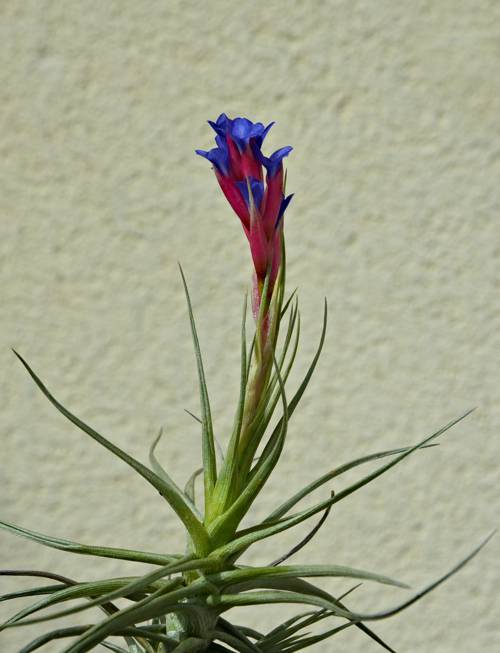
FAQ About Caring for Indoor Air Plants (Tillandsia)

What are air plants and how do they differ from other houseplants?
Air plants, also known as Tillandsia, are unique houseplants that do not require soil to grow. They belong to the bromeliad family and absorb water and nutrients through their leaves from the air. This makes them different from most traditional houseplants that require soil for nutrient uptake.

How often should I water air plants?
Air plants should generally be watered once a week by soaking them in water for about 20-30 minutes. In drier environments, they might need soaking every 4-5 days. After soaking, ensure they dry thoroughly, preferably within 4 hours, to prevent rot.

What kind of light do air plants need?
Air plants require bright, indirect light to thrive. They can also do well under fluorescent lighting if placed within a few feet of the source. Avoid placing them in direct sunlight for prolonged periods, as this can cause sunburn on their leaves.

Can I mount air plants on any surface?
Air plants can be mounted on a variety of surfaces, including wood, stones, and cork. However, avoid using copper materials as it can be toxic to them. Make sure there is adequate airflow around the plant, and do not use glue that can damage the plant tissues.

Do air plants flower, and how often?
Yes, air plants do flower, usually once in their lifetime. The blooming period depends on the species, and the flowers can last from a few days to several months. After they bloom, air plants often produce offsets, or "pups," which can be separated to grow new plants.

How can I reproduce air plants?
Air plants reproduce by producing "pups," which are smaller offsets growing at the base of the mother plant. Once these pups reach about one-third the size of the parent plant, they can be gently separated and grown individually.

What are the signs of overwatering air plants?
Signs of overwatering air plants include browning or blackening leaves, which often indicate rot, and a mushy texture when touched. To avoid this, ensure they dry completely after each watering session.

Is it necessary to fertilize air plants?
Fertilizing air plants is not strictly necessary, but it can help them grow healthier and encourage blooming. Use a bromeliad or air plant-specific fertilizer diluted to quarter strength, and apply once a month during the growing season.

Can air plants survive in low light conditions?
Air plants can survive in lower light conditions, but they won't thrive and may not grow as well as they would in brighter light. It's ideal to place them in a well-lit area to encourage healthy growth.

What is the best way to dry air plants after watering?
After soaking, place air plants upside down on a towel or rack in an airy space to dry. Make sure they are not in direct sunlight or in a sealed container to ensure proper air circulation, which helps prevent rot.

How do I know if my air plant is dehydrated?
A dehydrated air plant will have curled or rolled leaves, and it may appear dull in color. To rehydrate, soak the plant in water for a few hours, ensuring it dries completely afterward.

What are some common challenges when caring for air plants?
Some common challenges include ensuring they receive enough light without direct sunburn, avoiding overwatering, and maintaining proper air circulation. Monitoring these aspects can help in keeping air plants healthy.

Can air plants be placed outside?
Air plants can be placed outside, provided the environment is suitable. They may do well in shaded areas with good humidity and airflow, but they need protection from harsh sunlight and extreme temperatures.

How do I clean my air plants?
To clean air plants, gently rinse them with water during their weekly soak to remove dust and debris. Avoid using any chemical cleaners, as they can harm the plants.

Are air plants safe for pets?
Air plants are generally considered non-toxic to pets. However, it's always a good idea to keep them out of reach of curious animals to prevent them from being chewed or damaged.

What should I do if my air plant's leaves are turning brown?
If your air plant's leaves are turning brown, it could be a sign of underwatering or too much direct sunlight. Increase watering frequency or move the plant to a location with less intense light and ensure it dries properly after watering.

Do air plants need humidity?
Air plants thrive in environments with higher humidity levels, typically around 50-60%. In dry indoor conditions, more frequent watering or misting can help replicate this environment.

Can air plants be glued to surfaces for mounting?
While air plants can be glued to surfaces, it is safer to use fasteners like wire or fishing line to avoid damaging the plant. If using glue, ensure it is non-toxic and doesn't obstruct the plant's ability to access air and moisture.

What types of air plants are best for beginners?
Varieties such as Tillandsia ionantha, Tillandsia caput-medusae, and Tillandsia aeranthos are popular choices for beginners due to their resilience and ease of care. These species are adaptable and can tolerate a range of conditions.

How long do air plants typically live?
Air plants can live for several years, with many varieties surviving 2-5 years or more with proper care. After blooming, they will produce pups that continue the lifecycle, providing a continuous line of growth.
